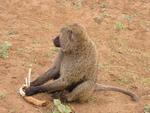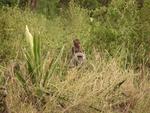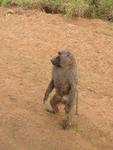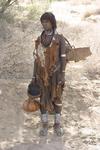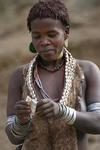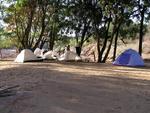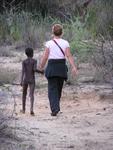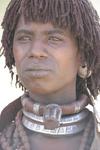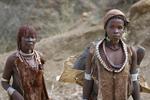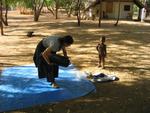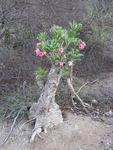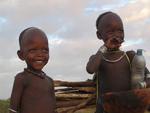We set off from Arba Minch for our journey into Omo proper. About
half hour's drive away we found some baboons by the side of the road.
These baboons were quite brave and would take food from your hand.
I held onto the bit of banana I gave and the baboon was quite
willing to actually touch my fingers.
A further twenty minutes and the landscape changed abruptly to what
looked like some kind of marshland. Three metre high platforms
could be seen in the fields for people to sit on as they protected
their crops presumably from birds. In one part of the marshland
something caught our attention. There was a bush shaped like a
T-Rex. If it had been a hap-hazard look-a-likey then we would have
put it down to chance but it was such a good T-Rex shape that we
were confused and discussed for a good five minutes whether it was
really chance or a habesha with a sense of humour.
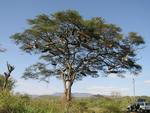 |
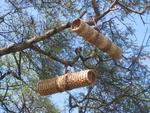 |
The land continued to change becoming drier as we put more distance
between us and Arba Minch. In the trees, hay could be seen drying.
Firew stopped the cars in front of a tree with many bee hives hung
from its branches. These hives belonged to the Zey Zey tribe. The
hives are made from hollowed out logs and vary between about 1m and
2m in length. As we got out and had a look we could hear the honey
guide bird. Tradition has it that the honey guide bird will lead you
to either honey or a lion. If you follow its calls until you reach
honey you are supposed to reward it with food. That explains the deal
that it has with humans. I'm more worried about its other deal, the
one with lions. What do the lions give it for bringing them food?
Firew backed this story up by saying that he has actually had a
honey guide led him to a lion. Lions are rare but they can
occasionally be found.
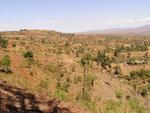 |
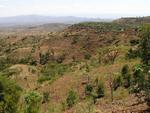 |
 |
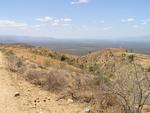 |
With the drive came more changes to the scenery, the soil became
redder and the vegetation started to disappear until it seemed that
only acacia, small cacti and thin, sickly bushes remained. However,
what remained was quite common, it would not be fair to say that it
was barren or a desert.
We broke our journey at Konso, a place that we were to return to
later. We stopped off at the Idget hotel (your choice on
how to pronounce it) before we continued with a journey down
to a restaurant along the road to Turmi. Firew told us that we
would be able to get the best tegamino here. He wasn't wrong.
Despite being in the middle of nowhere, the enjera was good quality
and the tegamino itself was excellent. The large lumps of raw garlic
were the only worry but it was so good. It's a bit far to go
though for a Sunday lunch.
The territory around us was now mostly flat although mountains
could be seen in the distance. Approaching lorries threw up
tall tails of dust in their wakes. Any air coming in through the
windows was hot and did little to cool you down. On the plains,
dust devils were being spontaneously created and then disappearing
as quickly as they had appeared. The only animals to be seen were
occasional birds or pairs of startled dik-diks darting
away.
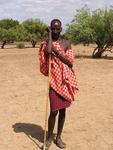 |
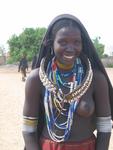 |
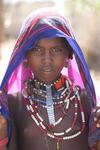 |
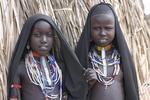 |
We stopped off at Arbore for our first 'tribe' visit. This was the
first time we paid to take photos of people. This was an odd
experience in itself and raises moral questions about whether
taking photos was the right thing to do. By paying for photos and
invading the villages we were changing their way of life. Given ten
years I can easily believe that the Arbore village will be completely
different. The price for photos was one birr per person in the
photo. There was some low grade hassle. Mostly people grabbing you
and saying "photo" because they wanted to be photgraphed. I was
surprised to find one person who could speak tigrinian, mostly they
spoke amharic and presumably a local language as well. In a pattern
that repeated itself many times, after paying them their birr,
they would never look happy, and pretty soon be back to saying "photo"
repeatedly. It was quite tiring.
After leaving Arbore we were quickly into Hamer territory.
Unfortunately I managed to get MC Hammer "You can't touch this" into
my head where it stayed for pretty much the whole time in Hamer land,
the only exception being Groove Armada's "ass shaking". Of course,
the people are nothing like MC hammer. If you have a Bradt guide then
you will see a young Hamer woman on the cover (we met her later but
she didn't have her child with her).
Our destination was a small campsite run by Hamer people. It was close
to a small town called Turmi. It is interesting to see what kind of
collection of huts counts as a town. Turmi is important for
trade though. As we approached Turmi we saw two Hamer women walking
along the road. The cars pulled over and one of the women ran off.
She seemed to either be mad or drunk. Her friend was persuaded to pose
for some photos. The scenery was dramatic but uniform in its colour
save bright splashes of pink from a tree with pink flowers (Daniel
suggested that it was Frangipani). These trees made only
a small part of the landscape though, the rest being dusty acacia
trees and thorny bushes.
The camp site was nice and we pitched up our tents under some trees
(i'm sure that there is something bad about being under trees but
I can't remember whether it is just in storms). Instead of hassle we
were greeted with smiles and polite requests to do our washing. Hamer
women and men were at the camp site hoping to sell their goods but
they went home as supper time approached. The camp site was a real
haven. Firew assured us that things would be safe here and that's
the impression we had, no worries about leaving cameras and money in
the tents. Because it was so hot, we only pitched up the inner part of
the tent, leaving the flysheet nearby in case of rain.
I sat on a log at the edge of the campsite, overlooking a dry riverbed
in front of me and some hill scrub to my right, while writing notes
for the diary entries. Small wild dogs appeared from the scrub
followed by three young Hamer women. The dogs, although not trained,
seemed to behave well around humans. Maybe they were domesticated but
I just couldn't tell. More women followed and the group walked up the
sandy river bed by the side of the site.
The campsites other attractions were a long drop toilet including what
Rob and I thought was a stick onto which you could hang, a shower
fed from a barrel of water, and some very noisy insects. I think
that they would be called cicadas but they were incredibly noisy
screeching in the trees above us. Sometimes they would all stop
at the same time and then one by one start again. Fortunately, after
darkness the whining stopped. By the way, the stick was part of a more
elaborate arrangement. On the end of the stick was a bit of wood cut
to the right shape to cover the hole of the long drop. Another feature
of the toilet was its open plan nature on three of its sides. Doing
VSO is certainly liberating.
We walked into town to get some soft drinks (laslasas). Ali had picked
up a little friend at the camp site. He seemed interested in
practising his English and just being with Ferenji. He was a sweet kid
and wasn't pushing for anything. Also, apart from the flip-flops
on his feet, he was butt naked. Starkers. In his birthday suit.
Completely nuddy. Well he didn't have a problem so nor did we. Nearby
we could hear a honey guide whistling to us. It has a peculiarly human
like song.
In addition to the pink flowers, a striking plant was a cactus plant
that had a light and dark green chequerboard pattern on it. I hadn't
noticed until we were up close to it. At the town of Turmi, we
met up with John and Eliza whom we had seen previously in Arba Minch.
They had managed to grab a lift from a pickup. They seemed quite happy
to find their own way. I'm sure that they will have some great stories
by the time that they have finished their journey. John was looking a
little pink because he was in the back of the pickup trying to protect
any exposed skin from the sun and dry, hot air.
Our walk back was very relaxed under gentle moonlight and quiet
surroundings.
